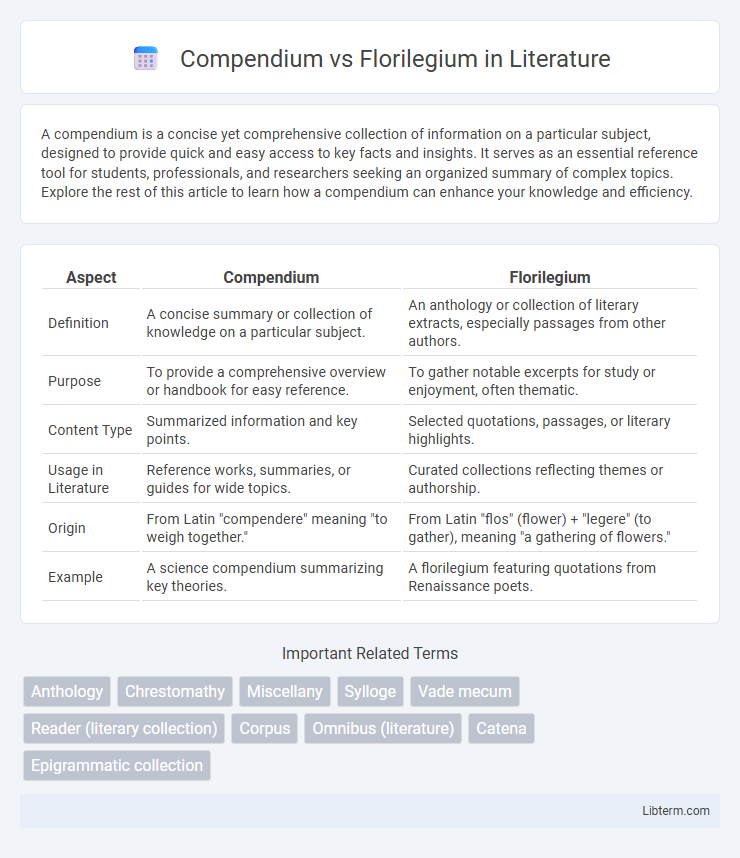A compendium is a concise yet comprehensive collection of information on a particular subject, designed to provide quick and easy access to key facts and insights. It serves as an essential reference tool for students, professionals, and researchers seeking an organized summary of complex topics. Explore the rest of this article to learn how a compendium can enhance your knowledge and efficiency.
Table of Comparison
| Aspect | Compendium | Florilegium |
|---|---|---|
| Definition | A concise summary or collection of knowledge on a particular subject. | An anthology or collection of literary extracts, especially passages from other authors. |
| Purpose | To provide a comprehensive overview or handbook for easy reference. | To gather notable excerpts for study or enjoyment, often thematic. |
| Content Type | Summarized information and key points. | Selected quotations, passages, or literary highlights. |
| Usage in Literature | Reference works, summaries, or guides for wide topics. | Curated collections reflecting themes or authorship. |
| Origin | From Latin "compendere" meaning "to weigh together." | From Latin "flos" (flower) + "legere" (to gather), meaning "a gathering of flowers." |
| Example | A science compendium summarizing key theories. | A florilegium featuring quotations from Renaissance poets. |
Introduction: Defining Compendium and Florilegium
A compendium is a concise collection of detailed information or summaries on a specific subject, designed to provide an accessible overview or quick reference. A florilegium, derived from Latin meaning "a gathering of flowers," traditionally refers to an anthology of selected excerpts from various authors or works, often emphasizing literary or philosophical texts. Both serve as curated compilations, but a compendium emphasizes comprehensive coverage, while a florilegium highlights curated selections of notable passages.
Historical Origins of Compendium
The historical origins of the compendium trace back to ancient Rome, where scholars and scribes compiled concise summaries of extensive texts to facilitate easier access to knowledge. Unlike the florilegium, which selectively gathers excerpts from various authors to highlight thematic ideas, the compendium serves as a structured consolidation of comprehensive information on a specific subject matter. This method of information organization became integral to medieval manuscripts, enabling efficient transmission of scholarly works across generations.
Historical Origins of Florilegium
The historical origins of florilegium date back to medieval Europe, where these collections of excerpts from classical and theological texts served as educational tools for scholars and clergy. Unlike a compendium, which provides a comprehensive summary of knowledge on a subject, a florilegium specifically gathers selected passages or quotations organized thematically or by author. This practice evolved from the Latin term "flos" meaning flower, symbolizing a "gathering of flowers" or choice pieces of literature, reflecting the florilegium's role in preserving and transmitting cultural and intellectual heritage.
Structural Differences: Compendium vs Florilegium
A compendium is a concise compilation of information, often organized in a systematic and hierarchical structure with clear headings and subheadings for quick reference. In contrast, a florilegium presents a curated collection of excerpts, typically arranged thematically or by author, prioritizing thematic coherence over strict structural order. The structural difference lies in the compendium's emphasis on comprehensive coverage and clarity, whereas the florilegium focuses on selective curation and thematic juxtaposition.
Purposes and Uses of a Compendium
A compendium serves as a concise, comprehensive summary of essential information, designed for quick reference and efficient knowledge retrieval across various subjects such as science, law, and literature. It organizes data systematically to aid researchers, students, and professionals in accessing key concepts without wading through extensive texts. Unlike a florilegium, which compiles select excerpts or quotations primarily for thematic or literary purposes, a compendium emphasizes holistic understanding and practical application of consolidated knowledge.
Purposes and Uses of a Florilegium
A florilegium serves as a curated collection of botanical illustrations or excerpts, primarily intended for study, appreciation, and preservation of plant diversity. Unlike a compendium that offers comprehensive summaries across various topics, a florilegium focuses on aesthetic and scientific documentation of plants, often used by botanists, artists, and historians. Its uses include enhancing botanical research, supporting educational endeavors, and facilitating the identification and cataloging of species within herbariums or botanical gardens.
Content Compilation Methods
Compendiums organize information through concise summaries and structured categories, making them accessible for quick reference and comprehensive overviews. Florilegia assemble selected excerpts from various original texts, emphasizing thematic or author-centric collections to highlight key ideas and stylistic elements. Both methods serve to curate knowledge, but compendiums prioritize breadth and structured clarity, whereas florilegia focus on thematic depth and curated literary or scholarly selections.
Academic and Literary Significance
Compendium and florilegium both serve as curated collections of knowledge, yet compendiums typically provide comprehensive, systematic coverage of academic subjects, facilitating efficient study and reference. Florilegia emphasize the literary and thematic selection of excerpts, often showcasing notable passages from diverse authors, thereby enriching literary analysis and appreciation. Their academic significance lies in compendiums' structured synthesis of information, while florilegia preserve and highlight the cultural and historical context of literary works.
Modern Examples and Applications
Modern compendiums, such as Wikipedia and specialized databases like the Medical Subject Headings (MeSH), provide systematic, comprehensive collections of information for research and education. Florilegia today appear in curated anthologies of poetry and thematic art collections, emphasizing selective, aesthetic compilations rather than exhaustive coverage. Digital platforms enable both formats to coexist, serving purposes from academic reference to cultural preservation and creative inspiration.
Choosing Between a Compendium and a Florilegium
Choosing between a compendium and a florilegium depends on the desired scope and purpose of the collection. A compendium offers a comprehensive summary of knowledge or information on a specific subject, ideal for in-depth study and reference. In contrast, a florilegium comprises carefully selected excerpts or quotations, suitable for thematic exploration or showcasing notable insights.
Compendium Infographic

 libterm.com
libterm.com